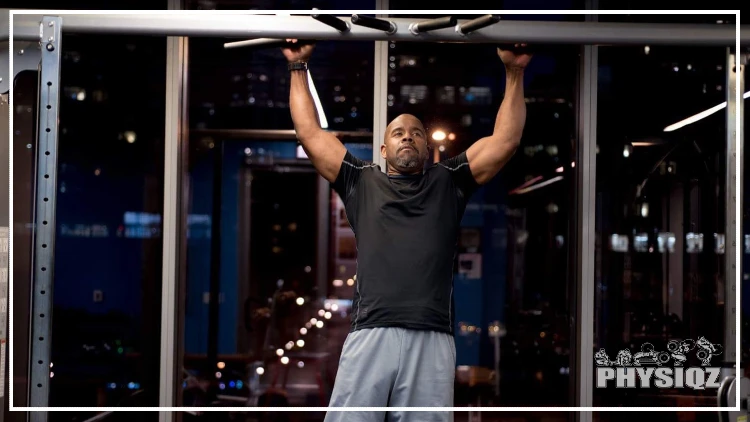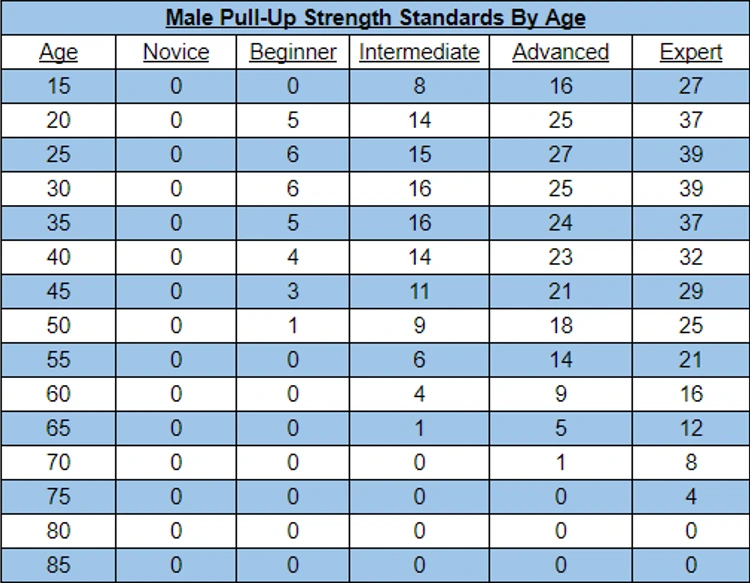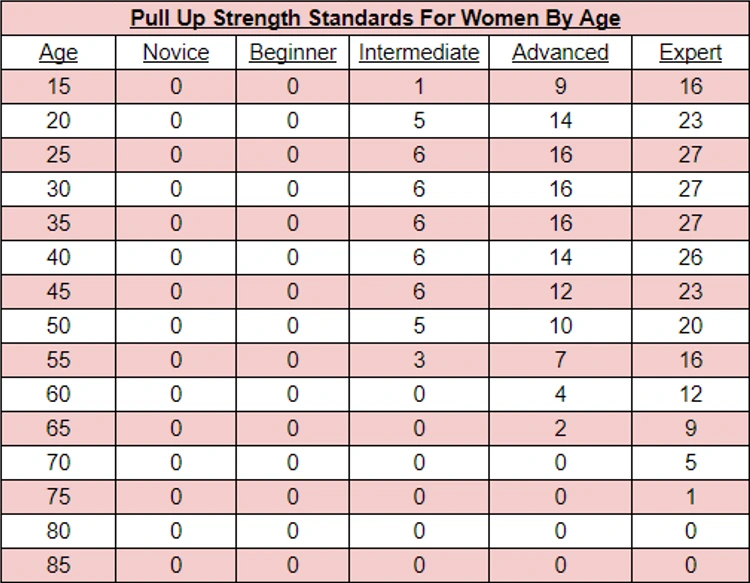
When it comes to pinpointing an average, pull ups by age charts help determine how many is okay, good and impressive even though the exact amount can still vary by a person’s age, level of fitness, and proficiency in the movement.1
While we can account for the above, how many men vs women should be able to will differ some due to biological and hormonal differences so a pull up strength standards chart for each is shown.
After seeing if the amount you can do is good or not, keep reading to see how many should be done for hypertrophy (building muscle), how often to train pull ups, the amount of recommended sets per session or week, the ideal rep range, how to do even more pull ups, and tips to perfect your form too.
How Many Pull-Ups Should I Be Able To Do?
There’s no single answer to how many pull ups a person should be able to do. Children, teenagers, and adults of different ages all have different strength standards to strive for.
Besides age, an individual’s size and training experience make a major difference. To join the Marines, someone needs to be able to do at least three pull ups but should be able to do up to ten.
This is also a good range for anyone to pursue if they want to achieve and maintain good back health but the Marine Corps standard isn’t the only standard. Athletes can shoot a lot higher, and very large people will do fewer pull ups even if they have excellent upper-body strength.
Plus, upper body strength declines later in life and the standards drop accordingly. While a man should be able to do 12+ pull ups in the prime of life, being able to do five pull ups at age 65 is a spectacular achievement.
Ultimately, pull up strength standards depend heavily on age, gender, and level of fitness.
Average Pull Ups by Age: Chart for Men & Women (Pull Up Strength Standards)
When it comes to the difficulty of the pull up vs push up, it’s no contest. Most people can do at least one push up, but most people who don’t do any physical training can’t even do a single pull up.
Even among people who exercise, pull up figures can stay at 0 into a person’s teenage years. From there, average pull up counts will grow dramatically in the next few decades before slowly declining after that.
However, this can vary from person to person depending on habits and training.
For instance, someone might go through their early life without being able to do any pull ups but turn things around by picking up an exercise habit in their 40s. Besides age, the other key quality is a man or woman’s level of experience with resistance training.
There are five categories for grouping people together and measuring their skill, which can estimate their pull up performance together with their age:
- Novice: Someone who just started resistance training and has only just begun to see any gains.
- Beginner: A person who’s been training consistently for 3-6 months. By this point, they’ll be considerably stronger but still below standards.
- Intermediate: Someone who’s been training for at least six months to two years and reached a decent level of strength. Intermediate strength standards reflect good health and the position that a person should be at at their age and size.
- Advanced: A high-performing athlete who’s consistently worked at resistance training for two to five years, using advanced techniques to push themselves further.
- Expert: The top one percent of lifters and the general population in terms of strength, they’ve been training for more than five years and seek to maximize their performance.
Lastly, a man vs woman will have different performances for their average pull-ups by age. Here are the pull up landmarks from age 15 to 85, the point by which it’s exceedingly rare to be able to do any pull ups at all.
Male Pull-Up Strength Standards By Age (Pull Up Chart for Men)
Pull ups are tough, and men who don’t do any resistance training will probably be unable to do any reps but the information below shows how much someone of each age should be able to achieve with just a little training.

Pull Up Strength Standards For Women By Age (Pull Up Chart for Women)
One notable insight that the women’s pull up strength standards reveal is that beginners of all ages will struggle to do a single pull up. However, women of most ages can do 15-25 pull ups with sufficiently intense and consistent training.

Average Pull-Ups by Age Chart Accuracy
The average pull-ups by age chart is a good rough guideline that’s generally accurate. However, it won’t apply as accurately to people who weigh less than 140 lbs or much more than 200 lbs.
People who are particularly heavy will have a harder time doing pull ups than the standard above, while lighter individuals should shoot higher.
However, the deviations shouldn’t be too extreme and most people should at least be able to hit the intermediate level of strength for their age group. If a person wants a more universal statistic to gauge their pull up strength, they can calculate their one-rep maximum (1RM) weight for a single weighted pull up.
Bodyweight differences from one person to the next will distort the number of reps a person can do, but 1RM is an absolute measurement of upper body strength.
Calculate Weighted Pull-Up 1RM Using the Pull Up Calculator & Formula
While bodyweight exercises like the pull up have great health benefits, they’re not as adaptable as exercises where a person can add and reduce weight. However, a person can perform weighted pull ups to stay in the ideal weight ranges to stimulate hypertrophy and follow a progressive overload workout plan.
The first step to take when incorporating weighted pull ups into a workout routine is to calculate 1RM from the number of reps a person can do.
There are several formulas to calculate 1RM, and the simplest of these is the Epley Formula.2 It goes 1RM = W (1+R/30), with W standing in for weight and R representing the number of reps.
So if a person who weighs 150 pounds does 15 pull ups, the formula would look like 150 (1+15/30), which gives that person’s weighted pull up 1RM as 225. By wearing 40 pounds of weighted gear, they could perform pull up reps at around 85% of their 1RM, an optimal range for strength gain and hypertrophy.
How Many Pull-Ups a Day To Build Muscle?
The pandemic helped popularize challenges to do different exercises every day, such as pull ups and push ups. A lot of people think there’s a magic number of each exercise to do daily if they want to get strong, but that’s the wrong approach.
Doing a demanding exercise like the pull up and pushing close to muscle failure demands 24-48 hours of recovery.3
While active recovery is better than total rest, pull ups are too demanding to be used as active recovery while the biceps and lats are still recovering.4 If a person tries to do pull ups daily, they’ll just hinder their own recovery and increase the risk of injury.

Source: Sir_hennihau on Pixabay5
The better question is how often to train pull ups, and how many sets to do each session and per week.
How Often To Train Pull Ups: Maximum Sets per Week & Session
Besides the benefits of increasing pull up weight, hitting volume targets is also key to maximize progress. That means challenging the body with multiple sets that come near muscle failure to promote muscle growth.
You might wonder about the muscles that works when doing pull ups. The pull up engages many recruiting muscles, but the main targets are the latisimuss dorsi (lats), the biceps, and the trapezius (traps).
The exact ideal levels of weekly volume vary from person to person and change over time, but the back muscles can handle 15-30 sets per week while the biceps are best suited to 14-20 sets per week. Divided between two or three sessions a week, that’s four to ten sets of pull ups each session but in all reality, horizontal pulling exercises like rows should be incorporated for a well-rounded back.
If a person only wants to train the back and biceps with the pull up, they should keep it within these bounds.
For optimal results, though, a person would be best off scaling down the pull up and incorporating other exercises. Isolation exercises such as dumbbell curls help target individual muscles, and they provide better results when combined with compound exercises like the pull up.
Training three to five sets of pull ups a session, twice a week while using sets of isolation exercises to reach back and bicep volume targets may be a better approach than doing 14-20 sets of pull ups each week. With this approach, the pull up is an especially good component on day two of a push/pull/legs routine (PPL).
How To Increase the Number of Pull Ups You Can Do at Any Age
Pull ups are great as part of a shoulder protocol to build strength and mobility, but the data on average pull-ups by age show that novices of most ages can’t do any pull ups. At this point, people often wonder how they can train the pull up if they can’t do any pull ups to start with.
The answer is that there are other exercises that a person can do to target the same muscle groups and build the foundational strength they need to master the pull up. Plus, someone who trains the pull up can use these exercises as low weight, high volume supplements to their pull up routine.
Try Out Band-Assisted Pull Ups & Machine Pull Ups at First
If it’s difficult to complete a full pull up repetition with proper form, there are other ways to get started and build strength before moving up to full pull ups. Loop resistance bands are a flexible way to take a few pounds off of a pull up and complete reps more easily.
Here, a person puts a foot in the loop band (be careful not to slip since the recoil can cause injury) and keeps their leg straight to maximize tension. This way, the band will offer significant support through much of the motion.
It’s a little awkward, but it has the benefit that all it takes is a pull up bar and a cheap resistance band to use this method anywhere. A major appeal of pull ups and other bodyweight exercises is that a person can complete them at home rather than at the gym, and this banded pull up approach makes assisted pull ups a workable home exercise.
A more graceful solution will probably require going to the gym and using a pull up machine.
There are two kinds of machines that help with pull ups: pull down machines, and assisted pull up machines. Pull down machines use a bar attached to a weight to simulate the motion of a pull up, but with more or less weight.6
Studies show that these exercises actually correspond to pull up strength almost perfectly, unlike other machine-based workouts.7
These are definitely among the best exercise machines for flabby arms, since they help train the biceps and build strength to perform proper pull ups.
In particular, variants consider variants like the close grip lat pulldown and the muscles that works in this exercise are the same as the regular pull up, but there’s a greater emphasis on the muscles of the lower back.
On the other hand, assisted pull up machines involve standing on a platform that’s attached to a counter-weight. This counter-weight actively pushes the user upward, which is very effective in helping them to perform easier pull ups.
Both machines are equally valid ways to build upper body strength and improve results on the pull up.
Negative (Eccentric) Pull-Up Reps
Eccentric exercises focus on the second half of a motion, lowering weight rather than lifting it. These motions are where the muscles are strongest, which makes them great choices for people of all strength levels.
For an eccentric pull up, a person will use a box, a platform, or something to help them reach the completed pull up position with their elbows at their sides and chest and the bar. Then, they raise their legs so that they’re now holding their own weight, and slowly lower themselves down to a dead hang.
This works all of the same muscle groups as a full pull up and is an excellent way to progress in strength.
Train Variations, Different Grips, & Supporting Exercises
The pull up can be done with a narrow grip or wide grip, as well as over hand (pronated) and underhanded (supinated) where the wider the grip is, the more it hits the lats, and the narrower the grip the more it hits your biceps and middle back.
Plus, if you’re not doing pull downs and rows to workout your entire upper back then you maybe limiting your ability to progress in pull ups too.
How To Do a Pull Up With Perfect Form
The first step in doing a pull up is to find a bar and position the hands correctly. Keep the back of the hands facing the body, and grip the bar wider than shoulder length.
Next, pull upward in a smooth motion as high as possible. Ideally the chest should reach the bar, but it’s not a problem if only a person’s face reaches it.
Hold the position for a moment, and then lower the body into a dead hang in a controlled manner. Then, repeat.
Take care to engage the core and keep the legs stable throughout the exercise. Swinging them around will create momentum that can help lift a person to the bar, which cheats the exercise and takes the load off of the arms and back.
Plus, awkward swinging motions expose the lower back to forces that increase the risk of injury.
Check out this video for more help in performing a pull up with perfect form:
Whatever Your Pull Up Variation, Train It Consistently
Now, a perfect pull up as described above specifically involves a wide, upperhand (pronated) grip and involves pulling up until the chest or face are level with the bar. This isn’t the only way to do a pull up, and different people will swear by pulling up to a certain height or using a certain grip.
There are subtle, yet important differences between the variations, such as the fact the chin up (underhand/supinated grip) is more demanding for the biceps but takes some of the load off of the back. But all versions of the pull up are fundamentally good exercises that will yield results for the back and biceps if done consistently.
At the bottom line, pick a grip and range of motion and stick with that version of the pull up for 2-4 months. With regular training, this should be the point where adaptations and strength gains begin to hit significant diminishing returns.
At this point, switch to a different grip style or a more demanding range of motion to challenge the muscles in dynamic, new ways. On the other hand, switching haphazardously between grips and ranges of motion in a matter of weeks will undermine progress.
Whether someone is a man or a woman, exceeding their average pull ups by age and hitting strength standards for this demanding exercise will go a long way to strengthen their upper body and maintain their quality of life.
Frequently Asked Questions
How Many Pull Ups Can the Average Person Do?
The average person can do between one and six pull ups depending on age and other demographic factors.
How Many Pull Ups Is Good for Most People?
Doing six pull ups as a woman or 14 pull ups as a man is a solid achievement that reflects good upper body strength.
How Does a Person’s Pull Up Count Change Over Time?
For most people, their pull up count will increase into adulthood and start to decrease in their 30s or 40s before hitting 0 sometime around retirement age.
How Many Pull Ups Are Required by the U.S. Military (Army, Navy SEALs Etc.)?
The Army, Air Force, and Navy don’t have pull up requirements, but high performance can amount to extra points on examinations or credit toward special achievements such as warhawk and thunderbolt status. The Marines require a minimum of three pull ups while the Navy Seals requires a minimum of 10.
What’s the Record for Most Pull Ups Done?
Kenta Adachi holds the record for 651 continuous pull ups, while Wang Xincheng holds the timed pull up record for 112 pull ups in three minutes.
How Many Pullups Can the Average Man Do?
The average man can be defined by level of fitness, age and many other factors but in general, the average man can perform 4-6 pull ups.
References
1Brown, Keven. “Free Image on Pixabay – Fitness, Pull Ups, Strong, Workout.” Pixabay, 4 December 2019. Accessed 19 April 2023. <https://pixabay.com/photos/fitness-pull-ups-strong-workout-4667733/>
2Wikipedia. (2022). One-Repetition Maximum. Wikipedia. <https://en.wikipedia.org/wiki/One-repetition_maximum>
3Morán-Navarro, R. (2017, September). Time course of recovery following resistance training leading or not to failure. NCBI. <https://pubmed.ncbi.nlm.nih.gov/28965198/>
4Martínez-Gómez, R. (2022, February). Comparison of Different Recovery Strategies After High-Intensity Functional Training: A Crossover Randomized Controlled Trial. NCBI. Comparison of Different Recovery Strategies After High-Intensity Functional Training: A Crossover Randomized Controlled Trial <https://pubmed.ncbi.nlm.nih.gov/35185620/>
5Hausen, Hendrik. “People Workout Athlete – Free photo on Pixabay.” Pixabay, 13 June 2018. Accessed 19 April 2023. <https://pixabay.com/photos/people-workout-athlete-man-outdoor-3467440/>
6Snarr, R. (2017, September). Electromyographical Comparison of a Traditional, Suspension Device, and Towel Pull-Up. NCBI. <https://www.ncbi.nlm.nih.gov/pmc/articles/PMC5548150/>
7Johnson, D. (2009, September). Relationship of lat-pull repetitions and pull-ups to maximal lat-pull and pull-up strength in men and women. NCBI. <https://pubmed.ncbi.nlm.nih.gov/19387371/>